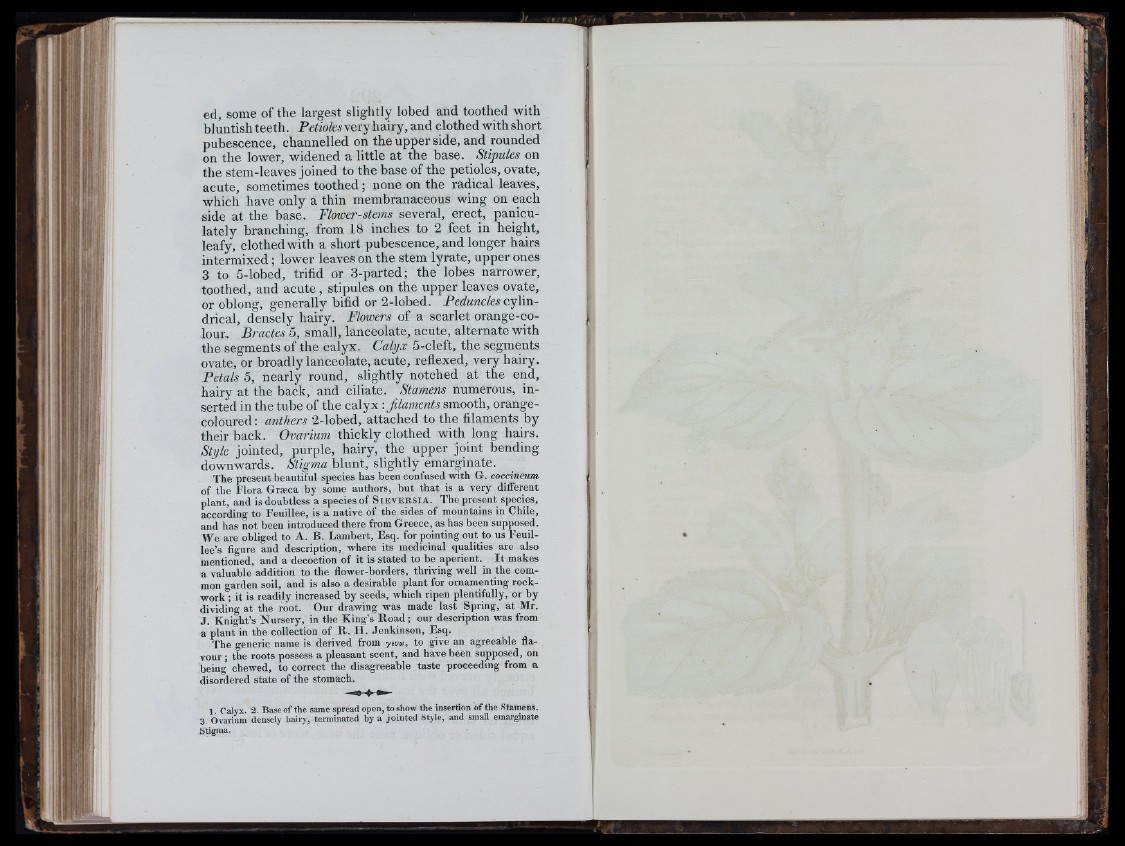
ed, some of the largest slightly lobed and toothed with
bluntish teeth. Peri'o/e. very hairy, and clothed with short
pubescence, channelled on the upper side, and rounded
on the lower, widened a little at the base. Stipules on
the stem-leaves joined to the base of the petioles, ovate,
acute, sometimes tooth ed ; none on the radical leaves,
which have only a thin membranaceous wing on each
side a t the base. Flower-stems several, erect, paniculately
branching, from 18 inches to 2 feet in height,
leafy, clothed with a short pubescence, and longer hairs
inte rm ix ed ; lower leaves on the stem lyrate, upper ones
3 to 5-lobed, trifid or 3-parted; the lobes narrower,
toothed, and a c u te , stipules on the upper leaves ovate,
or oblong, generally bifid or 2-lobed. Peduncles cylindrical,
densely hairy. Flowers of a scarlet orange-colour,
Bractes 5, small, lanceolate, acute, alternate w ith
the segments of the calyx. Calyx 5-cleft, the segments
ovate, or broadly lanceolate, acute, reflexed, very hairy.
Petals 5, nearly round, slightly notched at the end,
hairy a t the back, and ciliate. Stamens numerous, inserted
in the tube of the c a ly x : Jilaments smooth, orange-
coloured : anthers 2-lobed, attached to the filaments by
their back. Ovarium thickly clothed with long hairs.
Style jointed, purple, hairy, the upper joint bending
downwards. Stigma blunt, slightly emarginate.
The present beautiful species has been confused with G. coccineum
of the Flora Grzeca by some authors, but that is a very different
plant, and is doubtless a species of S i e v e r s i a . The present species,
according to Fenillee, is a native of tbe sides of mountains in Chile,
and has not been introduced there from Greece, as has been supposed.
W e are obliged to A. B. Lambert, Fsq. for pointing out to us Feuil-
lee’s figure and description, where its medicinal qualities are also
mentioned, and a decoction of it is stated to be aperient. I t makes
a valuable addition to the flower-borders, thriving well in the common
garden soil, and is also a desirable plant for ornamenting rock-
work ; it is readily increased by seeds, which ripen plentifully, or by
dividing at the root. Our drawing was made last Spring, at Mr.
J . Knight’s Nursery, in the King’s R o a d ; our description was from
a plant in the collection of R . H . Jenkinson, Esq.
The generic name is derived from yivu, to give an agreeable flavour
; the roots possess a pleasant scent, and have been supposed, on
being chewed, to correct the disagreeable taste proceeding from a
disordered state of the stomach.
1. Calyx. 2. Base o f the same spread open, to show the insertion of the Stamen.s.
3 Ovarium densely hairy, terminated by a jointed .Style, and small emarginate
Stigiwa.